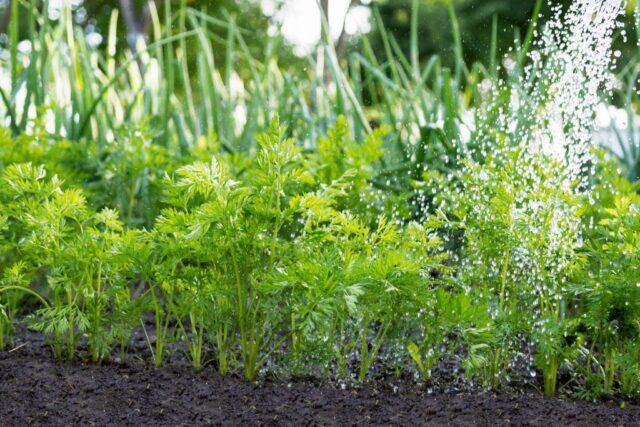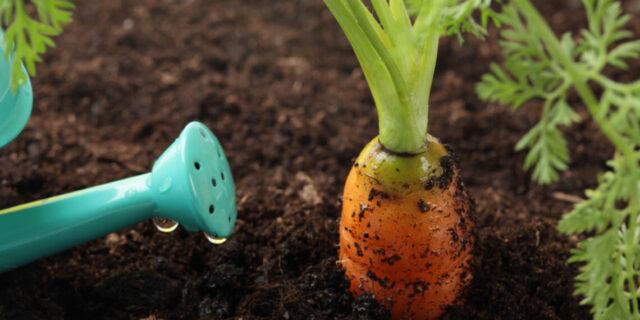Content
Watering carrots is one of the basic stages of crop care. Its correct schedule and volume ensure growth and development and a good harvest. The structure of root crops, their taste, juiciness, chemical composition, and appearance depend on watering.
How many times and when to water carrots in open ground
Features of watering carrots depend on the specific stage of its growing season. During its course, the main changes are the frequency and volume of hydration.
Watering carrots after planting seeds
When planting carrots, water the soil before planting the seeds. First, prepare the grooves, then moisten them. The seeds are sown after absorbing water.
If the soil is dry by the time of sowing, it is better to water the beds two days in advance. It is optimal to do this with a hose with a spray nozzle or watering can.
It takes approximately 1.5-2 weeks before emergence. Watering carrots after planting seeds in the ground during this period is mandatory; the soil should remain moderately moist. The volume of water and the frequency of its application are guided by the structure of the earth and weather conditions. To maintain soil moisture, you can cover it with film or mulch.
After emergence
When the carrot seeds hatch, water the plantings more frequently. The beds should not dry out. At the initial stage, the root system of the crop is weak, making it more difficult for it to absorb moisture. At this stage, frequent but rather shallow watering is needed. In cool weather, it is enough to do it every week. In hot weather, it is better to water carrots once every 4-5 days.

The need for watering carrots can be easily checked by the condition of the soil - if the top 2-3 cm is dry, and then the ground is moist, then irrigation is not required
During the formation of root crops
Active formation of root crops begins when their thickness is from 0.5 cm in the phase of 4-5 leaves. From this moment until the carrots ripen, they are watered infrequently, but abundantly. It is optimal to consume up to 12-17 liters of water per 1 m². The soil should be moistened 10-15 cm deep.
In June-July, it is enough to carry out 4-6 waterings per month. If the crop does not have enough moisture, growth will slow down and the quality of root crops will suffer significantly.
Watering carrots in August is enough 1-2 times a month. Water consumption is reduced to 5-6 liters per 1 m².
Carrots need to be watered if there is no rain. When there is heavy rainfall, the crop has enough moisture.
Do I need to water carrots before harvesting?
Stop watering carrots in September or another harvest month 2-3 weeks in advance. In dry weather, this period is reduced to 7-10 days. Light watering can be done a few days before harvest to make it easier to remove the roots from the ground.
How to properly water carrots in open ground
The best option for watering carrots is warm, settled water. The optimal temperature is 18-20 °C. For such purposes, it is good to have several large barrels or other containers on the site. Cool water will do, but not cold water. When the liquid settles, the salts settle and therefore do not end up on the beds, which is useful.
Water carrot beds early in the morning or in the evening after sunset. Irrigation of crops during the day is possible only on cloudy days; it should be carried out before lunch. It is more effective to water carrots in the evening when the air temperature drops. The crop will absorb more moisture overnight. When moisturizing in the morning, valuable water evaporates, especially in hot weather and drought.

The dark green color of the tops, their curling and wilting indicate a significant moisture deficiency - carrots need emergency watering
You can water carrot beds in different ways. At the initial stage, the root system has not yet become strong, so it is worth using a watering can with a spray nozzle. This method of watering is followed until seedlings emerge and for some time after that.
When the root system gets stronger, you can switch to the sprinkling method. This method of watering is as close as possible to the natural moistening of plants by precipitation. Thanks to sprinkling, the air supply of the crop is improved and the risk of waterlogging is eliminated. With this method of watering, it is effective to combine foliar feeding and preventive spraying against pests.
Some gardeners water carrot beds in furrows. This method is considered surface irrigation and is labor-intensive.
The most effective option is drip watering of carrots in open ground. Water is supplied in small portions as close to the root system as possible. Its supply is provided by tubes, hoses or tapes with special holes. The benefits of drip irrigation are many, including:
- less water consumption;
- exclusion of surface runoff;
- reduction of labor costs;
- possibility of simultaneous application of nutrients.
You can buy a ready-made system for drip irrigation of carrots or make it yourself. For convenience, you should pay attention to options with a timer.
Hilling also helps retain moisture in the ground. Additionally, this measure improves oxygen exchange and protects root crops from sunburn.
Combining watering with fertilizing
Watering carrots is often combined with fertilizing, since many preparations require the preparation of a solution. For 1-1.5 m² take a 10-liter bucket of water and the following substances:
- after the first thinning, 20-25 g of ammonium nitrate, 20 g of potassium chloride, 30 g of superphosphate;
- after the second thinning, 30 g of potassium chloride and superphosphate;
- at the beginning of August 30 g of potassium chloride.
Fertilizer solutions can be applied at the root, but it is better to make furrows, moving 5-10 cm away from the plants. After watering combined with fertilizing, loosening is necessary.
When shaping carrots, it is useful to use wood ash. It serves as a potassium fertilizer and prevents diseases and pests.A solution is made from wood ash and added to water for watering carrots at a ratio of 1:10.
Fertilizers are also applied in dry form. The required amount of substances is evenly distributed over the bed, then watered abundantly. The efficiency of this method is lower; to increase it, fertilizers must be placed not on the surface, but slightly deepened. The uniformity of their distribution depends on the structure and composition of the soil.

Carrots are always fertilized after rain or heavy watering or combined with it - this rule applies to all types of fertilizing
Common mistakes when watering and their consequences
Watering is one of the most important stages of caring for carrots. Gardeners often make mistakes that lead to unpleasant consequences:
- Alternating periods of dryness and high humidity. This happens during a rare visit to the garden, during which they try to do everything to the maximum. Due to such changes, the volume of the core of root vegetables increases sharply, which is why they crack.
- Water until harvest. This causes the carrots to crack.
- Excessive watering. With a constant excess of moisture, root vegetables accumulate few nutrients, lose their sweetness, and become tough and rough. Excessive watering significantly increases the risk of diseases, especially fungal diseases.
- Frequent watering, but in too small volumes. The carrots will be lethargic, small, and the growth of weeds will accelerate.
- Moisture deficiency. This slows down the growth and development of the crop, deprives the root crops of juiciness and sweetness, distorts them, and gives them an intense yellow color.
- Watering carrots in the sun. Due to the rapid evaporation of moisture, the plants will overheat and may get burned.
- Watering with cold water.Low temperatures cause crop stress, slow growth, and make plants more vulnerable to diseases and other negative factors.
Conclusion
Watering carrots is a must. The quantitative and qualitative characteristics of the crop depend on its correct implementation. The frequency of watering and water consumption are oriented towards the phase of crop development. Violation of the schedule, deficiency or excess of moisture, alternation of dry periods with overflows and other factors lead to negative consequences.








